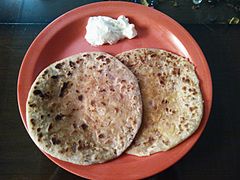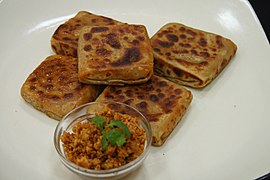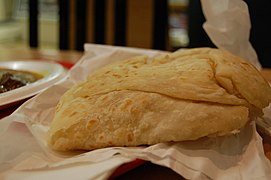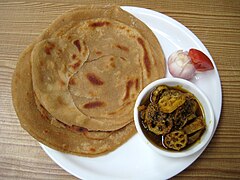Paratha
Paratha (pronounced [pəˈɾɑːtʰɑː], also parantha) is a flatbread from the Indian subcontinent.[1] It was mentioned in early medieval Sanskrit, India.[1] It is common in India, Sri Lanka, Pakistan, Nepal, Bangladesh, Maldives, Afghanistan, Myanmar,[2] Malaysia, Singapore, Thailand, Mauritius, Fiji, Guyana, Suriname, and Trinidad and Tobago where wheat is the traditional staple. It is one of the most popular flatbreads in the Indian subcontinent and the Middle East.[3][4]
 | |
| Place of origin | Indian subcontinent[1] |
|---|---|
| Region or state | Punjab |
| Associated national cuisine | India, Bangladesh, Fiji, Guyana, Malaysia, Maldives, Thailand, Myanmar,[2] Nepal, Pakistan, Middle Eastern, Singapore, Sri Lanka, Suriname, Trinidad and Tobago |
| Main ingredients | Atta, ghee/butter/cooking oil and various stuffings |
| Variations | Aloo paratha, Roti Canai, Wrap roti |
Paratha is an amalgamation of the words parat and atta, which literally means layers of cooked dough.[5] Alternative spellings and names include parantha, parauntha, prontha, parontay, paronthi (Punjabi), porota (in Bengali), paratha (in Odia,Urdu, Hindi), palata (pronounced: [pəlàtà]; in Myanmar),[2] porotha (in Assamese), forota (in Sylheti), farata (in Mauritius and the Maldives), prata (in Southeast Asia), paratha, buss-up shut, oil roti (in the Anglophone Caribbean) and roti canai in Malaysia and Indonesia.
-
Punjabi Aloo Paratha served with Butter, from India
-
Dhakai Paratha from West Bengal, India
-
Aloo paratha from northern India
-
Paratha served with tea in a Pakistani Hotel
-
Trinidadian-style roti paratha (buss-up shut)
-
In Myanmar, paratha is commonly eaten as a dessert, sprinkled with sugar.
-
Petai Paratha (Smashed Paratha), a West Bengal variant served with light vegetable curry
-
Lachha Paratha
References
change- ↑ 1.0 1.1 1.2 Chitrita Banerji (10 December 2008). Eating India: An Odyssey into the Food and Culture of the Land of Spices. Bloomsbury Publishing. pp. 119–. ISBN 978-1-59691-712-5.
- ↑ 2.0 2.1 2.2 Joe Cummings (2000). Myanmar (Burma). Lonely Planet. ISBN 9780864427038.
- ↑ "Al Islami Foods Expands into Frozen Dough Market with New Paratha - the Halal Times". 17 March 2021.
- ↑ Beranbaum, Rose Levy (30 September 2003). The Bread Bible. W. W. Norton & Company. ISBN 978-0-393-05794-2.
- ↑ Verma, Neera. Mughlai Cook Book. Diamond Pocket Books (P) Ltd. ISBN 9788171825479 – via Google Books.









